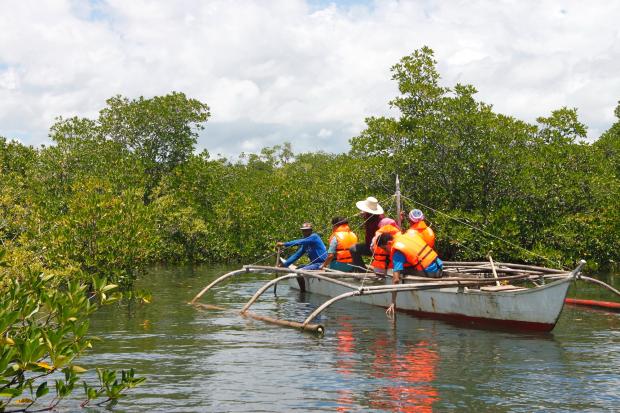Cabgan Is. mangroves, bats to give nature lovers a show
 Some tourists may think they have seen enough of Bohol, but there is definitely more to this Central Visayas province than the Chocolate Hills, old churches, and Panglao’s white sand beaches.
Some tourists may think they have seen enough of Bohol, but there is definitely more to this Central Visayas province than the Chocolate Hills, old churches, and Panglao’s white sand beaches.
Something new is being offered for visitors in Tubigon town which just opened its 80-hectare Cabgan Island for tourists’ exploration.
This, Tubigon Vice Mayor Virgillio Fortich said, would change the role of Tubigon from being a mere access point for tourists to being a destination in itself.
The island, which is within the territory of barangay Macaas, has 24 kinds of mangroves and two kinds of bats. The island’s name Cabgan comes from the Visayan word “kabog” which means bat.
After two years of planning, the Cabgan island ecotourism now opens with the newly established community-based association ‘Malamboong Turismo sa Macaas, Tubigon’ (Matu-matu) organized by Boboi Costas of Grassroots Travel.
Costas said numerous meetings took place between the Macaas barangay council, the Tubigon municipal government and the Department of Environment and Natural Resources (DENR). He is happy that the “long overdue project” is finally taking off.
“We’re on the stage where we’re tweaking everything. What’s fantastic about this is that the local government is very responsive and very supportive of this project,” Costas said.
Barangay Macaas, where the port of Cabgan Island is located, is about 20 minutes from Tubigon’s pier. One may reach the barangay by boarding a tricycle. Fare is only P20, and one is treated to clean fresh air and an enchanting scenery of vast green fields along the way.
At the site, an abandoned old house serves as reception area where middle-aged men and women in Filipino costumes greet visitors with a Visayan song and leis and fresh buko juice.
From the reception area, local guide translators will walk you through mangroves and to the port where a small BFAR-donated boat that can accommodate not more than 10 people will transport tourists to a larger boat waiting on deeper waters.
Once the tourists are settled in the big boat, they will be taken closer to the mangroves. At this point, a tourist guide will explain what to expect on the tour.
With welcoming smiles and high spirits, the locals of Cabgan then began speaking: “Ako si Marissa Sacol. Ako ang inyung tour guide.” (I am Marissa Sacol. I am your tour guide.)
She went on to identify the large flying fox in the island which feed on fruits and chicken. From the mountains, these bats go to Cabgan island as early as 3 a.m.
The chickens that fell prey to the bats “don’t feel pain,” she claimed, as the bats’ teeth “have anesthesia.”
Finishing only first year in high school, Sacol, 42, was adept at the scientific names of the mangroves.
“Mao ni siya ang rhizopora mucronata, unya kana kay sonneratia alba” she pointed out as her husband, the banca operator, paddled.
A mother of seven children, she is happy to be part of Matu-matu because she used to just stay home relying only on her fisherman-husband.
Matu-Matu president Jonathan Zabate is happy with how things are turning out.
Costas emphasized that part of the beauty of ecotourism is that it employs the community. Aside from the usual means of livelihood in barangay Macaas, people could now earn from tourism.
Zabate, a former OFW, said they’ve had three instructors regarding bats, two instructors on mangroves, three on cultural mapping, and one in food and beverage and housekeeping..
Some bancas had a telescope ready so tourists can see the bats more clearly.
Towards the end of the tour, Sacol also shared one of the many stories their local folklore such as folk healers or “mananambals” and white ladies roaming the mangrove forests.
“Ilaha ra manang protektahan. Dili sila ganahan ug saba,” she said. (They’re protecting the mangroves. They don’t want noise.)
Part of ecotourism is serving local cuisine which tourists can try after the tour. After the meal with singing Matu-matu members, visitors are then given a 20-minute discussion about the importance of mangroves and bats.
A group of five can avail of the tour at P850 per head. For groups of 15-20, the fee is P750 per person.
Proceeds will be shared by the Macaas barangay council, Tubigon municipal government and Matu-matu.
Interested parties may contact Anil (09423846405) or Jonathan (09223623801) of Matu-Matu.
Disclaimer: The comments uploaded on this site do not necessarily represent or reflect the views of management and owner of Cebudailynews. We reserve the right to exclude comments that we deem to be inconsistent with our editorial standards.
